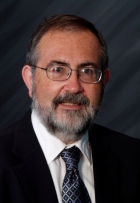Events
-
Speaker
Guillermo García-Pérez, Departament de Física de la Matèria Condensada, Universitat de BarcelonaDescription
Primes have fascinated and puzzled scientists in different disciplines for the last two and a half thousand years. The importance of primes transcend theoretical aspects, and practical applications include public key cryptography algorithms and pseudorandom number generators. Despite all the efforts and their apparent simplicity, the elucidation of patterns in the sequence of primes remains a major challenge. In our work, we introduce a new dimension that allows us to understand primes and their statistical properties not in isolation but as building blocks of natural numbers. We propose to fuse together number theory and graph theory in the context of complex networks and stochastic processes presenting a dynamical model that naturally generates random primes as well as the relation between primes and composites with remarkable accuracy.
-

Speaker
Herbert Levine, Center for Theoretical Biological Physics (CTBP), Rice University, HoustonDescription
Eukaryotic cells can move either individually or collectively and this property is crucial for many biological functions. Often cells use directional information to decide on their direction; for single cells this can take the form of chemical or mechanical gradients. For collective motion, additional information can be obtained from neighboring cells through such processes as the contact inhibition of locomotion. Our group develops a variety of computational models for studying actin-based crawling motions. These models range from rather complex and detailed at the single cell levels to simple reduced representations that can handle tissue-level processes. This talk will focus on out recent progress in this direction, specifically on collective chemotaxis of cellular clusters and the role of contact inhibition in the mechanical state of expanding tissues.
-
Speaker
Emanuele Cozzo (BIFI, Zaragoza)Description
The real power of representing a complex system through a graph lies in the hypothesis that the structure and function of the system under study are intimately related to one another.
Now, we understand multiplex networks as a non-linear superposition of complex networks, where components interact through a variety of different relationships and communication channels, which we conceptualize as different layers of the multiplex network. This conceptualization of a multiplex network poses a number of challenges: from its formal description to the ultimate goal of understanding how this new level of structural complexity reveals itself in the functioning of the system.
In this seminar, we will start by dealing with the representation of multiplex networks in terms of graphs and matrices. We will give the basic definitions that underpin the notion of multiplex networks, basically facing the problem of setting a formal language that includes the new level of complexity represented by the superposition of different layers of interaction.
We will show that generalizing traditional metrics to multiplex networks ``the naive way'' usually leads to blurred results, while constructing on first principles leads to well-defined metrics that may unveil ``how multiplexity works''. This is the case, for example, for our definition of clustering coefficients for multiplex networks, which enlightens the context dependent nature of social relations.
We address the problem of the structural characterization of a multiplex network by means of its spectral properties, with special attention to "structural transitions".
Finally, we will show how the critical properties of a model are affected by the structural characteristics of the multiplex networks via its spectrum. -
Seminar: Re-Descubriendo la Estadística Bayesiana, una manera de aproximar muchos sistemas complejos
Speaker
David Conesa, Universitat de ValènciaDescription
¿Qué es la Estadística Bayesiana y porqué está tan de moda ahora cuando se conoce desde hace tiempo (mucho de hecho)? Esta pregunta será el hilo conductor de esta charla, en la que visitaremos en qué consiste esta visión de la Estadística a la vez que veremos cómo nos puede permitir resolver problemas complejos (de ahí que esté de moda) gracias a la forma que tiene de abordarlos. La idea principal que hay detrás de esta visión es que la información previa que tengamos sobre el problema a analizar debe ser incluida también en el análisis. El hecho de que los parámetros sean considerados como variables aleatorias nos permite ser capaces de expresar el conocimiento previo de una manera natural. La charla incluirá algunos ejemplos de aplicación que nos darán una idea de las capacidades de esta aproximación.
Inscripció al seminari gratuïta: enllaç
-
Speaker
Agnieszka Czaplicka, IFISCDescription
We consider the competition of two mechanisms for adoption processes: a so-called complex threshold dynamics and a simple Susceptible-Infected-Susceptible (SIS) model. Separately, these mechanisms lead, respectively, to first order and continuous transitions between non-adoption and adoption phases. We couple the two adoption processes in a complex network with two interconnected layers. We find that the transition points and also the nature of the transitions are modified in the coupled dynamics. In the complex adoption layer, the critical threshold required for extension of adoption increases with interlayer connectivity whereas in the case of an isolated single network it would decrease with average connectivity. In addition, the transition can become continuous depending on the detailed inter and intralayer connectivities. In the SIS layer, any interlayer connectivity leads to the extension of the adopter phase. Besides, a new transition appears as as sudden drop of the fraction of adopters in the SIS layer. The main numerical findings are described by a mean-field type analytical approach appropriately developed for the threshold-SIS coupled system.
